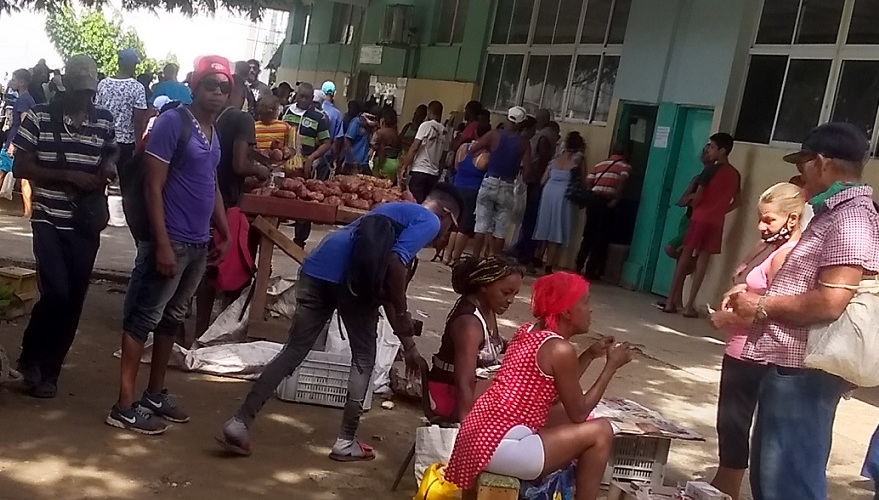Choosing between eating, washing or dressing: this is the socialist roulette in which thousands of families from Santiago live, plagued by a shortage of food and other basic necessities, the rise in prices and the meager purchasing power of their wages.
"Now what do I do? Should I buy the grocery allotment, soap, toothpaste or liquid detergent? It arrives once in a blue moon, and if I miss out I'm out of luck," Aleida asked at a bodega in Calle Nueva
Rosa, as exasperated as her friend, commented that at home "the chicken looks like mincemeat when it doesn't look like rice. We can't even scrap to come up with one meal a day. I'm fed up with soup and sick and tired of scrimping and saving."
Yarelis complained vociferously about the police because at the Micro 7 supermarket, in the José Martí District, subsidized products end up on the black market "right under their noses, with criminals and administrative leaders wheeling and dealing."
"This is a kind of hell," said Maria Antonia. "Some live off whatever they can come up with, others off remittances... this is supposed to be a wonderful island, but pockets are empty, women can buy one pair of panties a year, and the hardships leave you screaming."
Near the intersection of Trocha and Cristina, Bebita said that on "Day Zero", as the Government calls that on which the monetary unification will begin, "not just the gratuities, subsidies and the convertible peso must disappear, but everything paid to organizations that survive off political shenanigans. If they want more sacrifices, let them set an example."
These and other comments reflect the dire atmosphere in Santiago de Cuba, where prices and the lack of liquidity prevent many from being able to provide for their families, which have become more destitute ever since the pandemic hit an already feeble economy.
The cost of protein in the province's more than 3,200 agricultural markets and points of sale generates heated arguments, in which customers almost always end up the losers, and vulnerable people cannot even participate.
A package of hot dogs in the city costs 70 pesos, a pound of chicken, 50; pork, 60; lamb, 65; and ham, 90.
A pound of powdered milk costs 100 pesos; a string of onion, 250; and a bulb of garlic, 200. For a bunch of plantains you have to pay 150 pesos, for burro bananas, 25; a pound of taro costs 20 pesos, and one of beans is between 15 and 30, depending on the sellers.
The fruits and vegetables hawked by some 500 off-the-cart sellers and nearly 1,600 street vendors are also sold at prices most cannot afford.
In a tour of the municipality DIARIO DE CUBA found that six bananas cost 20 pesos; a jar of guava, 40; a pound of cucumber, 20; chili pepper, 30; and tomatoes, starting at 50, up to what the owner asks for.
Referring to the issue, Olga Thaureaux, the director of the regime's Sierra Maestra newspaper, wrote in the print edition from October 31: "You don't know what to do: shop, go out to find an inspector (whom we hardly ever see or cannot identify) or call them out for this disrespectful and otherwise illegal act."
After holding the Administrative Board responsible, the official added: "Then one realizes that alone he cannot tilt against windmills. And anger and powerlessness are swelling in the population."
The gap is so great that in less than a month Vice-president Salvador Valdés Mesa has traveled three times to try to address the imbalance and try to stem the rise of misery in the territory that has the lowest salaries on the island.
According to Valdés Mesa, inefficiency, together with the poor design of production and accommodation plans, are stifling state efforts and reveal the misguided practice of covering up, with the increase in prices, the business sector's non-viability.
For decades Santiago de Cuba invoked the infertility of its lands to receive almost 70% of the food that it needs from other regions, such as Granma, Matanzas, Ciego de Ávila and even Pinar del Río.
The Laguna Blanca food plan, however, the main of its kind in the province, is one of the most inefficient in the country. Since its creation at the end of the 80s it has committed a series of mistakes, such as never exploiting the main pumping station on the Cauto River, which would have bolstered yields.
Decades of irresponsibility complicate the food situation in the municipality, which is the most populated in the nation and, according to the 2019 demographic yearbook, has more inhabitants than the provinces of Mayabeque, Cienfuegos, Sancti Spíritus, Ciego de Ávila and Artemisa.
The nutritional imbalance caused by the lack of food and the excessive rise in prices particularly affect the 32,000 seniors who live alone in the city of Santiago de Cuba, although they also negatively affect the subsistence of the province's 110,000 children.
